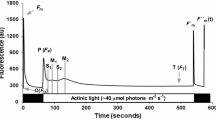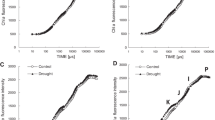Abstract
Chlorophyll (Chl) a fluorescence measurements as evaluators of plant freezing tolerance are frequently insufficiently sensitive to detect the early metabolic changes that are initiated following exposure to freezing temperatures. Using cold-acclimated winter wheat, I analysed the polyphasic transience (from 50 µs to 1 s) of Chl a fluorescence. This enabled detailed studies of the progressive energy flows and efficiencies within the photosystem 2 (PS2) complex that ensue following initial exposure to freezing temperatures right through to the plant recovery stage. The initial consequences of mild frosts that may cause primary damage involve a disturbance to the energy transfer subsequent to QA (the primary quinone electron acceptor of PS2). Lower freezing temperatures, on the other hand, may deter energy flow between the PS2 reaction centre (RC), Chl, and QA. All primary damage could only be repaired partially. Further freezing-triggered dysfunction of the electron transfer between the PS2 RCs and QA was connected with secondary damage that could lead to PS2 deactivation. Both primary and secondary freezing damages were reflected in decreased PIABS, the Performance Index based on equal absorption that characterizes all energy bifurcations in PS2. PIABS also differentiated cultivars with contrasting freezing-tolerance either subsequent to the onset of freezing or during the recovery stage. In contrast, the potential quantum yield of PS2 (Fv/Fm), which characterizes efficiency of energy trapping in the PS2 RCs, was only different in cultivars with contrasting freezing-tolerance during the recovery stage.
Similar content being viewed by others
Abbreviations
- ABS:
-
absorption flux
- Area:
-
pool size of electron acceptors from PS2 (proportional to the oxidized plastoquinone pool)
- Chl:
-
chlorophyll
- CS:
-
leaf cross-section
- DI:
-
dissipation flux
- ET:
-
electron transport flux
- EL:
-
electrolyte leakage from leaves
- F0 :
-
fluorescence of dark-adapted leaves in time 0
- Fm :
-
maximum fluorescence in dark-adapted leaves
- Fv :
-
fluorescence change between F0 and Fm (Fv = Fm − F0)
- Fv/Fm :
-
quantum efficiency of energy trapping in PS2 reaction centres
- PIABS :
-
performance index based on the equal absorption
- PPFD:
-
photosynthetic photon flux density
- PS2:
-
photosystem 2
- QA :
-
primary quinone electron acceptor of PS2
- QB :
-
secondary quinone electron acceptor of PS2
- RC:
-
reaction centre
- RC/CS0 and RC/CSm :
-
minimal and maximal densities of active reaction centres per leaf cross-section
- TR:
-
energy flux for trapping
References
Adams, G.T., Perkins, T.D.: Assessing cold tolerance in Picea using chlorophyll fluorescence.-Environ. exp. Bot. 33: 377–382, 1993.
Arora, R., Palta, J.P.: In vivo perturbation of membrane-associated calcium by freeze-thaw stress in onion bulb cells: simulation of this perturbation in extracellular KCl and alleviation by calcium.-Plant Physiol. 87: 622–628, 1988.
Arora, R., Palta, J.P.: A loss in the plasma membrane ATPase activity and its recovery coincides with incipient freeze-thaw injury and postthaw recovery in onion bulb scale tissue.-Plant Physiol. 95: 846–852, 1991.
Binder, W.D., Fielder, P.: Chlorophyll fluorescence as an indicator of frost hardiness in white spruce seedlings from different latitudes.-New Forests 11: 233–253, 1996.
Clark, A.J., Landolt, W., Bucher, J.B., Strasser, R.J.: Beech (Fagus sylvatica) response to ozone exposure assessed with a chlorophyll a fluorescence performance index.-Environ. Pollut. 110: 1–7, 2000.
Clement, J.M.A.M., van Hasselt, P.R.: Chlorophyll fluorescence as a parameter for frost hardiness in winter wheat. A comparison with other hardiness parameters.-Phyton (Ann. Rei. Bot. Austria) 36: 29–41, 1996.
COBORU: [Descriptive List of Cultivars of Agricultural Plants.]-Research Centre For Cultivar Testing, Nowa Słupia 2005. [In Polish.]
Ensminger, I., Busch, F., Huner, N.P.A.: Photostasis and cold acclimation: sensing low temperature through photosynthesis.-Physiol. Plant. 126: 28–44, 2006.
Flint, H.J., Boyce, B.R., Brattie, D.J.: Index of injury, a useful expression of freezing injuries to plant tissues as determined by the electric method.-Can. J. Plant Sci. 47: 229–239, 1967.
Griffith, M., Brown, G.N., Huner, N.P.A.: Structural changes in thylakoid proteins during cold acclimation and freezing of winter rye (Secale cereale L. cv. Puma).-Plant Physiol. 70: 418–423, 1982.
Hermans, C., Smeyers, M., Rodriguez, R.M., Eyletters, M., Strasser, R.J., Delhaye, J.P.: Quality assessment of urban trees: A comparative study of physiological characterisation, airborne imaging and on site fluorescence monitoring by the OJIP-test.-J. Plant Physiol. 160: 81–90, 2003.
Huner, N.P.A., Öquist, G., Hurry, V.M., Krol, M., Falk, S., Griffith, M.: Photosynthesis, photoinhibition and low temperature acclimation in cold tolerant plants.-Photosynth. Res. 37: 19–39, 1993.
Janowiak, F., Tantau, H., Dörffling, H., Dörffling, K.: Photosynthetic efficiency measured by chlorophyll a fluorescence is a reliable indicator of low temperature tolerance of crops.-Adv. agr. Sci. Problem Issues 496: 125–131, 2004.
Koch, M.D., Lehman, E.O.: Resistenzeigenschaften im Gärsten und Weizensortiment Gatersleben. 7. Prü fung der Frostresistenzpflanze.-D.A.I. XIV: 263–282, 1969.
Krause, G.H., Grafflage, S., Rumich-Bayer, S., Somersalo, S.: Effects of freezing on plant mesophyll cells.-In: Long, S.P., Woodward, F.I. (ed.): Plants and Temperature. Pp. 311–327. Company of Biologists, Cambridge 1988.
Krause, G.H., Weis, E.: Chlorophyll fluorescence as a tool in plant physiology. II. Interpretation of fluorescence signals.-Photosynth. Res. 5: 139–157, 1983.
Levitt, J.: Responses of Plants to Environmental Stresses.-Pp. 168–187. Academic Press, New York-London 1972.
Lovelock, C.E., Jackson, A.E., Melick, D.R., Seppelt, R.D.: Reversible photoinhibition in antarctic moss during freezing and thawing.-Plant Physiol. 109: 955–961, 1995.
McKersie, B.D., Murnaghan, J., Bowley, S.R.: Manipulating freezing tolerance in transgenic plants.-Acta Physiol. Plant. 19: 485–495, 1997.
Neubauer, C., Schreiber, U.: The polyphasic rise of chlorophyll fluorescence upon onset of strong continuous illumination: I. Saturation characteristics and partial control by the photosystem II acceptor side.-Z. Naturforsch. 42c: 1246–1254, 1987.
Neuner, G., Buchner, O.: Assessment of foliar frost damage: a comparison of in vivo chlorophyll fluorescence with other viability tests.-J. appl. Bot. 73: 50–54, 1999.
Quilliam, R.S., Swarbrick, P.J., Scholes, J.D., Rolfe, S.A.: Imaging photosynthesis in wounded leaves of Arabidopsis thaliana.-J. exp. Bot. 57: 55–69, 2006.
Rapacz, M.: Frost resistance and cold acclimation abilities of spring-type oilseed rape.-Plant Sci. 147: 55–64, 1999.
Rapacz, M., Gąsior, D., Zwierzykowski, Z., Leśniewska-Bocianowska, A., Humphreys, M.W., Gay, A.P.: Changes in cold tolerance and the mechanisms of acclimatation of photosystem II to cold hardening generated by anther culture of Festuca pratensis × Lolium multiflorum cultivars.-New Phytol. 161: 105–114, 2004.
Rizza, F., Pagani, D., Stanca, A.M., Cattivelli, L.: Use of chlorophyll fluorescence to evaluate the cold acclimation and freezing tolerance of winter and spring oats.-Plant Breed. 120: 389–396, 2001.
Sror, H.A.M., Tischendorf, G., Sieg, F., Schmitt, J.M., Hinchab, D.K.: Cryoprotection protects thylakoids during a freeze-thaw cycle by a mechanism involving stable membrane binding.-Cryobiology 47: 191–203 2003
Steffen, K.L., Arora, R., Palta, J.P.: Relative sensitivity of photosynthesis and respiration to freeze-thaw stress in herbaceous species. Importance of realistic freeze-thaw protocols.-Plant Physiol. 89: 1372–1379, 1989.
Strand, M., Öquist, G.: Effects of frost hardening, dehardening and freezing stress on in vivo chlorophyll fluorescence of seedlings of Scots pine (Pinus sylvestris L.).-Plant Cell Environ. 11: 231–238, 1988.
Strasser, B.J., Strasser, R.J.: Measuring fast fluorescence transients to address environmental questions: The JIP test.-In: Mathis, P. (ed.): Photosynthesis: From Light to Biosphere. Vol. V. Pp. 977–980. Kluwer Academic Publ., Dordrecht-Boston-London 1995.
Strasser, R.J., Srivastava, A., Govindjee: Polyphasic chlorophyll a fluorescence transient in plants and cyanobacteria.-Photochem. Photobiol. 61: 32–42, 1995.
Strasser, R.J., Srivatava, A., Tsimilli-Michael, M.: The fluorescence transient as a tool to characterize and screen photosynthetics samples.-In: Yunus, M., Pathre, U., Mohanty, P. (ed.): Probing Photosynthesis: Mechanisms, Regulation and Adaptation. Pp. 445–483. Taylor and Francis, London-New York 2000.
Strasser, R.J., Tsimilli-Michael, M.: Stress in plants, from daily rhythm to global changes, detected and quantified by the JIPTest.-Chimie nouvelle (SRC) 75: 3321–3326, 2001.
Taulavuori, K., Taulavuori, E., Sarjala, T., Savonen, E.-M., Pietiläinen, P., Lähdesmäki, P., Laine, K.: In vivo chlorophyll fluorescence is not always a good indicator of cold hardiness.-J. Plant Physiol. 157: 227–229, 2000.
Thebud, R., Santarius, K.A.: Effects of freezing on spinach leaf mitochondria and thylakoids in situ and in vitro.-Plant Physiol. 68: 1156–1160, 1981.
Tsimilli-Michael, M., Eggenberg, P., Biro, B., Köves-Pechy, K., Vörös, I., Strasser, R.J.: Synergistic and antagonistic effects of arbuscular mycorrhizal fungi and Azospirillum and Rhizobium nitrogenfixers on the photosynthetic activity of alfalfa, probed by the chlorophyll a polyphasic fluorescence transient O-J-I-P.-Appl. Soil Ecol. 15: 169–182, 2000.
Verhoeven, A.S., Adams, W.W., III, Demmig-Adams, B.: Close relationship between the state of the xanthophyll cycle pigments and photosystem II efficiency during recovery from winter stress.-Physiol. Plant. 96: 567–576, 1996.
Author information
Authors and Affiliations
Rights and permissions
About this article
Cite this article
Rapacz, M. Chlorophyll a fluorescence transient during freezing and recovery in winter wheat. Photosynthetica 45, 409–418 (2007). https://doi.org/10.1007/s11099-007-0069-2
Received:
Accepted:
Issue Date:
DOI: https://doi.org/10.1007/s11099-007-0069-2




